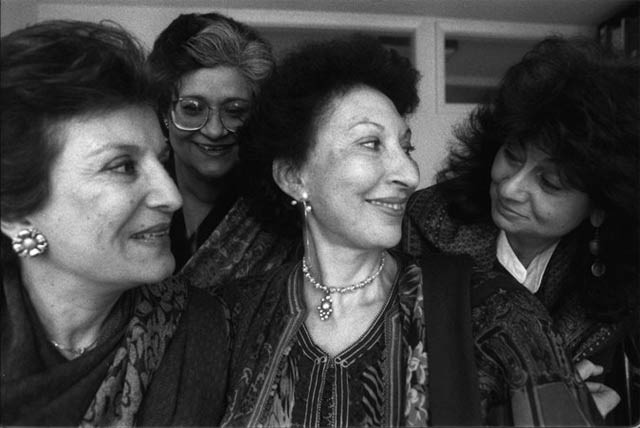Fatema Mernissi, founder of Islamic feminism, dies at 75
Fatema's best-known English-language books include Beyond the Veil: Male-Female Dynamics in Modern Muslim Society

Fatema Mernissi, a Moroccan sociologist who was one of the founders of Islamic feminism, whose work included studies of the sexual politics of Islamic Scripture and a memoir of her childhood in a domestic harem, died on November 30 in Rabat. She was 75.
The cause was cancer, said her literary agent, Edite Kroll. A longtime faculty member of Mohammed V University in Rabat, the capital, Professor Mernissi, who wrote in Arabic, French and English, published and lectured worldwide.
Deconstructing myths and misconceptions
Her best-known English-language books include “Beyond the Veil: Male-Female Dynamics in Modern Muslim Society,” which was first published in 1975 and is still considered a touchstone in the field; “Islam and Democracy: Fear of the Modern World” (1992, translated by Mary Jo Lakeland); and her memoir, “Dreams of Trespass: Tales of a Harem Girlhood” (1994), with photographs by Ruth V Ward.
“Muslim women are now producing the most exciting feminist writing being published anywhere,” The Guardian, the British newspaper, wrote in 1992. Professor Mernissi, it added, “is the most highly regarded among them.”
Throughout her work, Professor Mernissi, who favoured a moderate, inclusive Islam, emphasised that her deep study of religious texts had turned up little support for women’s long subordination. That reading, she argued, sprang from centuries of misinterpretation by male leaders intent on maintaining the sexual status quo.
“Not only have the sacred texts always been manipulated, but manipulation of them is a structural characteristic of the practice of power in Muslim societies,” Professor Mernissi wrote in “The Veil and the Male Elite: A Feminist Interpretation of Women’s Rights in Islam” (1991, translated by Ms. Lakeland). “Since all power, from the seventh century on, was only legitimated by religion, political forces and economic interests pushed for the fabrication of false traditions.”
Can a woman only choose one – hijab or a successful career?
One of the primary ways in which this manipulation played out, Professor Mernissi argued, was in Islam’s time-honoured control of the physical space that women are allowed to occupy. The most — or, more accurately, the least — visible manifestation of such control was the domestic harem.
Domestic harems, Professor Mernissi stressed, were nothing like the silk-hung dens of iniquity presided over by sultans and long popularized in Western film and literature. They were instead, quite simply, sequestered multigenerational living quarters for the female members of an extended family. Through his harem, a man maintained his honour by preserving his wives and daughters from the eyes of male outsiders.
“It is the Ottoman imperial harem that has fascinated the West almost to the point of obsession,” Professor Mernissi wrote in her memoir. “By contrast, domestic harems,” she added, “are rather dull, for they have a strong bourgeois dimension.”
It was into just such a harem that Fatema Mernissi was born on September 27, 1940, in Fez, the daughter of a prosperous family.
The harem’s matriarch, her grandmother, had been one of her grandfather’s nine wives. Though Professor Mernissi’s father, a monogamist, was a progressive in many respects, he favoured the traditional segregation of the sexes that the harem provided.
The Mernissi harem comprised a set of secluded quarters within the family’s expansive home. The women were rarely allowed to venture outside the house, and when they were, they did so — veiled — escorted by a male relative.
“A harem was about private space and the rules regulating it,” Professor Mernissi wrote in her memoir. “Once you knew what was forbidden, you carried the harem within.” She added, “Ours in Fez was like a fortress.”
Islam, modernity and women’s rights
Inside, the women dreamed of transgressing its confines. They sustained one another with stories, songs and, when they could spirit away the key to the radio cabinet, quiet news of the outside world.
Many, including Professor Mernissi’s mother, chafed openly. “I would wake up at dawn,” Professor Mernissi recalled her mother saying. “If I only could go for a walk in the early morning when the streets are deserted. The light must be blue then, or maybe pink, like at sunset. What is the color of the morning in the deserted, silent streets?”
Professor Mernissi added, “No one answered her questions.” Especially popular among the women were tales of Scheherazade, the Arab queen of legend who used her verbal skill to pre-empt execution. Professor Mernissi came to venerate her as a feminist heroine and in 2001 published “Scheherazade Goes West: Different Cultures, Different Harems,” a book-length study of her influence.
Unlike her mother and grandmother, who were uneducated, Professor Mernissi was a beneficiary of the nationalist fervor that had arisen in Morocco in the 1930s as the country sought to break free of French dominion.
As a young child she attended nationalist schools, where she was educated alongside male classmates. In 1956, when Morocco won its independence, the nationalists’ reforms included the dissolution of harems throughout the country.
More power to the women and less to the dupatta
Professor Mernissi received a degree in sociology from Mohammed V University, did graduate work at the Sorbonne and earned a PhD from Brandeis University. Her dissertation became her first book, “Beyond the Veil.”
Because of the politically charged nature of her work, Professor Mernissi sometimes found her public lectures interrupted by protests from Islamic fundamentalists. But for the most part — owing in no small measure to the careful phrasing and rigorous scholarly documentation of her writings — she was left alone.
“At least in Morocco, you can’t be put into jail for writing something, unlike most of the other Arab countries,” she told The Toronto Globe and Mail in 1982. “If those fanatics from the Moslem Brothers show up and try to interrupt my talk, they must be thrown out. I know now how to handle them. I won’t let them interrupt my work.”
Nor did she exempt the West from criticism on matters of sexual politics. Where the East subordinated women by controlling space, Professor Mernissi argued, the West created a vast de facto harem by controlling time.
“The Western man,” she wrote, “declares that in order to be beautiful, a woman must look 14 years old. If she dares to look 50, or worse, 60, she is beyond the pale. By putting the spotlight on the female child and framing her as the ideal of beauty, he condemns the mature woman to invisibility.”
Long active with North African social justice causes, Professor Mernissi helped found La Caravane Civique, an organization that took educated women to speak in rural communities, village schools and women’s prisons in the region. She also started a writing workshop for released Moroccan political prisoners.
Professor Mernissi, who never married, is survived by a brother, Mohamed, and a sister, Ratida Mernissi.
Her other books include “Women in Moslem Paradise” (1986); “Doing Daily Battle: Interviews With Moroccan Women” (1988), based on her fieldwork in rural areas and translated by Ms. Lakeland; “The Forgotten Queens of Islam” (1993), also translated by Ms. Lakeland; and “Women’s Rebellion and Islamic Memory” (1996).
In 2003, Professor Mernissi, along with Susan Sontag, received the Prince of Asturias Award for Letters, presented by the government of Spain.
After a lifetime spent exploring the relationship of Islam to feminism, Professor Mernissi concluded that there were few irreconcilable differences between the two.
“If women’s rights are a problem for some modern Muslim men, it is neither because of the Quran nor the Prophet (pbuh), nor the Islamic tradition, but simply because those rights conflict with the interests of a male elite,” she wrote in “The Veil and the Male Elite.”
“The elite faction is trying to convince us that their egotistic, highly subjective and mediocre view of culture and society has a sacred basis,” she added. “But if there is one thing that the women and men of the late 20th century who have an awareness and enjoyment of history can be sure of, it is that Islam was not sent from heaven to foster egotism and mediocrity.”
This article originally appeared on the New York Times, a partner of The Express Tribune.



















COMMENTS
Comments are moderated and generally will be posted if they are on-topic and not abusive.
For more information, please see our Comments FAQ